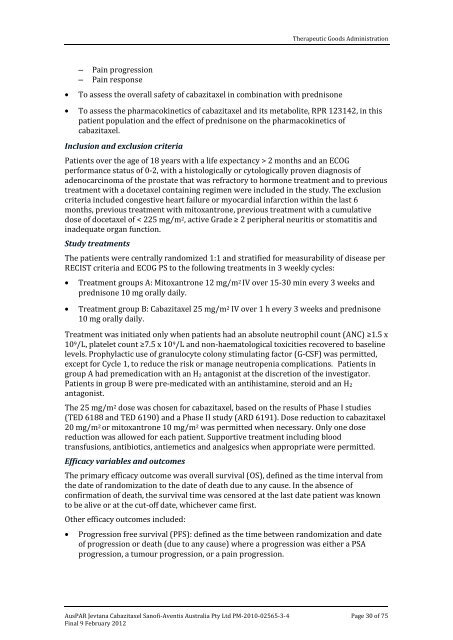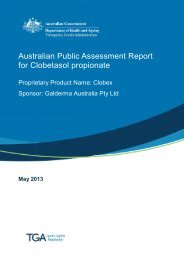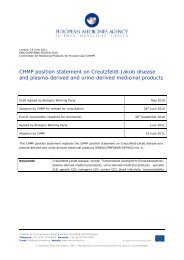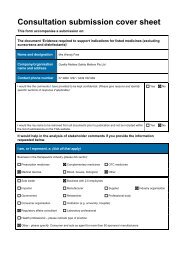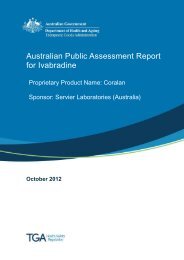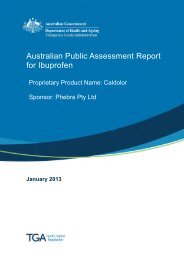AusPAR: Cabazitaxel - Therapeutic Goods Administration
AusPAR: Cabazitaxel - Therapeutic Goods Administration
AusPAR: Cabazitaxel - Therapeutic Goods Administration
You also want an ePaper? Increase the reach of your titles
YUMPU automatically turns print PDFs into web optimized ePapers that Google loves.
– Pain progression<br />
– Pain response<br />
<strong>AusPAR</strong> Jevtana <strong>Cabazitaxel</strong> Sanofi-Aventis Australia Pty Ltd PM-2010-02565-3-4<br />
Final 9 February 2012<br />
<strong>Therapeutic</strong> <strong>Goods</strong> <strong>Administration</strong><br />
• To assess the overall safety of cabazitaxel in combination with prednisone<br />
• To assess the pharmacokinetics of cabazitaxel and its metabolite, RPR 123142, in this<br />
patient population and the effect of prednisone on the pharmacokinetics of<br />
cabazitaxel.<br />
Inclusion and exclusion criteria<br />
Patients over the age of 18 years with a life expectancy > 2 months and an ECOG<br />
performance status of 0-2, with a histologically or cytologically proven diagnosis of<br />
adenocarcinoma of the prostate that was refractory to hormone treatment and to previous<br />
treatment with a docetaxel containing regimen were included in the study. The exclusion<br />
criteria included congestive heart failure or myocardial infarction within the last 6<br />
months, previous treatment with mitoxantrone, previous treatment with a cumulative<br />
dose of docetaxel of < 225 mg/m2, active Grade ≥ 2 peripheral neuritis or stomatitis and<br />
inadequate organ function.<br />
Study treatments<br />
The patients were centrally randomized 1:1 and stratified for measurability of disease per<br />
RECIST criteria and ECOG PS to the following treatments in 3 weekly cycles:<br />
• Treatment groups A: Mitoxantrone 12 mg/m 2 IV over 15-30 min every 3 weeks and<br />
prednisone 10 mg orally daily.<br />
• Treatment group B: <strong>Cabazitaxel</strong> 25 mg/m 2 IV over 1 h every 3 weeks and prednisone<br />
10 mg orally daily.<br />
Treatment was initiated only when patients had an absolute neutrophil count (ANC) ≥1.5 x<br />
10 9/L, platelet count ≥7.5 x 10 9/L and non-haematological toxicities recovered to baseline<br />
levels. Prophylactic use of granulocyte colony stimulating factor (G-CSF) was permitted,<br />
except for Cycle 1, to reduce the risk or manage neutropenia complications. Patients in<br />
group A had premedication with an H2 antagonist at the discretion of the investigator.<br />
Patients in group B were pre-medicated with an antihistamine, steroid and an H2<br />
antagonist.<br />
The 25 mg/m 2 dose was chosen for cabazitaxel, based on the results of Phase I studies<br />
(TED 6188 and TED 6190) and a Phase II study (ARD 6191). Dose reduction to cabazitaxel<br />
20 mg/m 2 or mitoxantrone 10 mg/m 2 was permitted when necessary. Only one dose<br />
reduction was allowed for each patient. Supportive treatment including blood<br />
transfusions, antibiotics, antiemetics and analgesics when appropriate were permitted.<br />
Efficacy variables and outcomes<br />
The primary efficacy outcome was overall survival (OS), defined as the time interval from<br />
the date of randomization to the date of death due to any cause. In the absence of<br />
confirmation of death, the survival time was censored at the last date patient was known<br />
to be alive or at the cut-off date, whichever came first.<br />
Other efficacy outcomes included:<br />
• Progression free survival (PFS): defined as the time between randomization and date<br />
of progression or death (due to any cause) where a progression was either a PSA<br />
progression, a tumour progression, or a pain progression.<br />
Page 30 of 75


